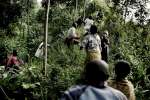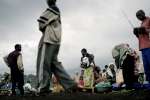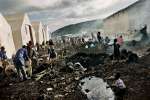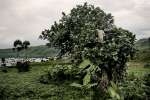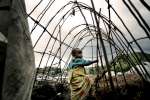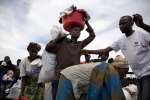- Text size
 |
|  |
|  |
| 
- Français
Ukraine internal displacement nears 1 million as fighting escalates in Donetsk region
News Stories, 6 February 2015
KYIV, Ukraine, February 6 (UNHCR) – The UN refugee agency reported on Friday that fighting in eastern Ukraine's Donetsk region is creating new displacement and pushing the number of registered internally displaced people (IDP) close to the 1 million mark.
Ukraine's Ministry of Social Policy puts the number of registered IDPs countrywide at 980,000 – a figure that is expected to rise as more newly uprooted people are being registered. In addition, some 600,000 Ukrainians have sought asylum or other forms of legal stay in neighbouring countries, particularly the Russian Federation, but also Belarus, Moldova, Poland, Hungary and Romania, since February 2014.
Spokesman Adrian Edwards told journalists in Geneva that UNHCR teams were reporting that heavy fighting in the Donetsk region over the last two weeks has resulted in massive destruction of buildings and infrastructure and in the collapse of basic services.
"Local authorities have begun to evacuate people from conflict areas, but many are still trapped by the fighting, including in basements and buildings under constant bombardment. The evacuations are being organized by the government helped by local volunteers," he said.
More than 2,800 civilians, including about 700 children and 60 people living with disability, have been evacuated from the towns of Debaltseve, Avdiivka and Svitlodar, which have seen fierce combat. Several incidents of shelling of buses carrying the evacuees have been reported.
The Ukrainian government has said it is concerned that areas close to the frontline, which are also under heavy shelling, will not be able to accommodate the new arrivals. Therefore, people will have to be moved further away to central, southern and western parts of the country.
Evacuees are being taken to government-controlled towns to the north of Donetsk such as Slovyansk, Sviatohirsk, Kramatorsk and Grodivka, as well as to the nearby Kharkiv region. They are being transported in cars and buses and, in the case of the most vulnerable, by train. Some evacuees are temporarily accommodated in train carriages at the railway station in Slovyansk, awaiting onwards transportation.
Apart from the organized evacuations, civilians continue to flee the conflict areas by their own means, facing numerous dangers along the way. "As more homes and other civilian infrastructure is damaged or destroyed, UNHCR expects more people to be displaced to areas in central, southern and western Ukraine under the control of the Ukrainian government, but also to non-government controlled areas in the Donetsk and Luhansk regions," Edwards said.
Our teams on the ground report that many of the recently displaced are arriving with very few belongings and without proper winter clothes. To address the most urgent needs, UNHCR, through local NGO networks, has started to distribute relief items in northern areas of the Donetsk region, the main place of arrival of IDPs from the conflict areas. Some 2,000 of the most vulnerable new arrivals received blankets, sleeping bags, bed linen, warm clothes and jerry cans.
Additionally, some 1,600 newly arrived IDPs from Debaltsevo and Vuhlehirsk have been assisted by UNHCR partners in conflict-affected areas which are not controlled by the government.
The lack of access to public services previously provided by the central authorities has drastically worsened the plight of the civilian population in areas not under government control. This has been further aggravated by restrictions to the movement of people and goods. The surge in fighting has further limited the supply of urgently needed goods in the conflict areas.
"UNHCR maintains its call on all parties to the conflict to refrain from any actions that might endanger the life of civilians and to adhere to the principles of international humanitarian law," Edwards stressed.
By Nina Sorokopud in Kyiv, Ukraine

